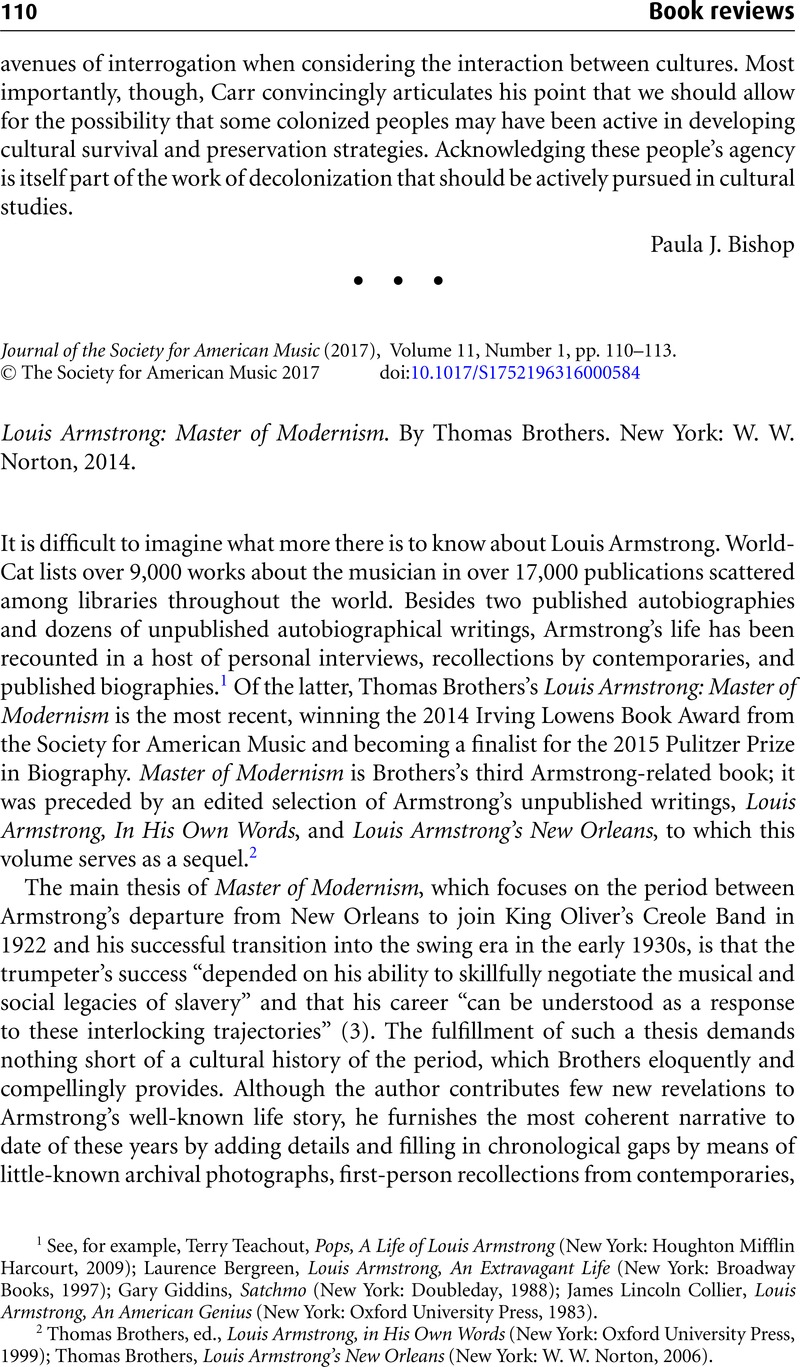No CrossRef data available.
Article contents
Louis Armstrong: Master of Modernism. By Thomas Brothers . New York: W. W. Norton, 2014.
Published online by Cambridge University Press: 16 January 2017
Abstract

- Type
- Book Review
- Information
- Copyright
- Copyright © The Society for American Music 2017
References
1 See, for example, Teachout, Terry, Pops, A Life of Louis Armstrong (New York: Houghton Mifflin Harcourt, 2009)Google Scholar; Bergreen, Laurence, Louis Armstrong, An Extravagant Life (New York: Broadway Books, 1997 Google Scholar); Giddins, Gary, Satchmo (New York: Doubleday, 1988)Google Scholar; Collier, James Lincoln, Louis Armstrong, An American Genius (New York: Oxford University Press, 1983)Google Scholar.
2 Brothers, Thomas, ed., Louis Armstrong, in His Own Words (New York: Oxford University Press, 1999)Google Scholar; Brothers, Thomas, Louis Armstrong's New Orleans (New York: W. W. Norton, 2006)Google Scholar.
3 See Brian Harker's discussion of this problematic term in his review of Louis Armstrong's New Orleans for the Journal of the American Musicological Society 61, no. 1 (2008): 228.
4 Brothers, Thomas, “Solo and Cycle in African-American Jazz,” Musical Quarterly 78, no. 3 (1994): 479–509 CrossRefGoogle Scholar.
5 Ibid., 488–89.
6 Ibid., 488.
7 In her review of the book, Eunmi Shim finds the multiple utilizations of fixed and variable to render the concept “meaningless.” See Shim, Eunmi, review of Louis Armstrong: Master of Modernism, by Thomas Brothers, Notes: Quarterly Journal of the Music Library Association 72, no. 1 (2015): 137–38CrossRefGoogle Scholar.
8 The curious chord in bar two (the flat submediant or “barbershop chord” in place of the usual subdominant) further illustrates Armstrong's close attention to harmony; see Hobson, Vick, Creating Jazz Counterpoint: New Orleans, Barbershop Harmony and the Blues (Jackson, MS: University Press of Mississippi, 2014), 62 Google Scholar. Armstrong's predilection for voice-leading over harmony has been previously noted. See this reviewer's The Original Hot Five Recordings of Louis Armstrong (Hillsdale, NY: Pendragon Press, 2007), 160, 186.
9 Schuller, Gunther, Early Jazz: Its Roots and Early Development (New York: Oxford University Press, 1968), 103 Google Scholar; Harker, Brian, Louis Armstrong's Hot Five and Hot Seven Recordings (New York: Oxford University Press, 2011), 48–59 Google Scholar; Schuller, Gunther, The Swing Era (New York: Oxford University Press, 1989), 173–77Google Scholar; Gushee, Lawrence, “The Improvisation of Louis Armstrong,” in In the Course of Performance: Studies in the World of Musical Improvisation, ed. Nettl, Bruno and Russell, Melinda (Chicago: University of Chicago Press, 1998), 320–21Google Scholar.
10 See Brian Harker's review for alternative views of Armstrong's apparent embrace of racist and demeaning stereotypes and Bruce Boyd Raeburn's review for his response to Brothers's harsh portrayal of white “alligators.” Brian Harker, review of Louis Armstrong: Master of Modernism, by Thomas Brothers, Music and Letters 96, no. 3 (2015): 484–86; Bruce Boyd Raeburn review of Louis Armstrong: Master of Modernism, by Thomas Brothers, in American Music 32, no. 3 (2014): 357–58.


